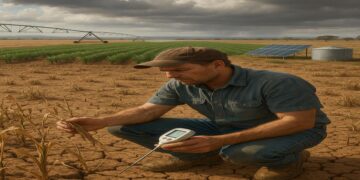The influence of climate change on the Australian economy: risks and opportunities

Understanding Australia’s Climate Change Impact
Australia is experiencing profound changes in its environment due to climate change, which directly influences various sectors of its economy. The rising temperatures, altered precipitation patterns, and an increase in the frequency and severity of natural disasters create both risks and opportunities. Grasping these factors is essential for stakeholders, ranging from farmers and business owners to policymakers and environmentalists.
Key Influences on Major Sectors
- Agriculture: Farmers across Australia are at the mercy of climate variability. Frequent droughts, particularly in regions like New South Wales and Queensland, can devastate crop yields, leading to a direct impact on food supply and prices. Conversely, heavy rainfall and flooding can damage infrastructure and soil quality, further complicating production. The unpredictability of these weather patterns makes sustainable management practices vital to ensure food security.
- Tourism: Australia’s natural beauty, from the Great Barrier Reef to the Outback, attracts millions of tourists each year. However, an increase in extreme weather events, such as bushfires and cyclones, can deter potential visitors. For example, the 2019-2020 bushfire season led to significant cancellations across the tourism sector. On the flip side, these changes promote a rise in eco-tourism, where visitors seek experiences that highlight sustainability and conservation efforts, potentially benefiting local economies.
- Insurance: The insurance sector faces mounting pressures due to the increasing number of claims related to natural disasters. As severe weather patterns become more common, insurance premiums in high-risk areas tend to rise. For instance, homeowners in bushfire-prone regions find it increasingly difficult to obtain affordable coverage, which emphasizes the urgent need for proactive risk management and climate adaptation strategies.
Opportunities for a Sustainable Future
Despite the challenges posed by climate change, Australia has the potential to emerge stronger through the transition to a greener economy. This transition opens up new opportunities across various sectors:
- Renewable Energy: The Australian government is pushing for greater investments in renewable energy sources such as solar and wind power. With abundant sunlight and coastal winds, these renewable technologies can create jobs, stimulate local economies, and reduce reliance on fossil fuels. For example, the installation of large-scale solar farms in regions like Western Australia has already begun providing substantial employment opportunities.
- Sustainable Practices: Many businesses are shifting towards sustainable practices to attract eco-conscious consumers. This trend is evident in the food industry, where farmers are embracing organic farming methods and ethical sourcing, appealing to a market that values health and environmental responsibility.
- Innovation: Australia is home to a burgeoning tech sector responding to climate challenges with innovative solutions. Startups focused on climate-responsive technologies, like carbon capture and smart agriculture tools, represent not just an investment opportunity but also a necessary evolution towards sustainability. These advancements can enhance productivity while safeguarding the environment.
By embracing these changes, Australia can transform potential setbacks into avenues for resilience and growth. The transition requires cooperation from all sectors, emphasizing the importance of a robust response to climate challenges. Through collective action, Australia can forge a sustainable economic future, balancing environmental health with economic vitality.
The Economic Landscape Amid Climate Change
The influence of climate change on the Australian economy is pervasive and multifaceted, manifesting notable risks across various sectors while also offering innovative opportunities for growth. Understanding this dual nature is crucial as Australia grapples with shifting landscapes, both literally and figuratively. A thorough exploration into key sectors reveals how intertwined climate change is with economic stability and development.
Key Economic Risks from Climate Change
The repercussions of climate change are not abstract concepts; they directly affect livelihoods and economic output. Here are several critical areas where these risks are especially pronounced:
- Agriculture: The agricultural sector, a cornerstone of Australia’s economy, faces substantial threats from changing climate patterns. Prolonged droughts can lead to diminished crop yields, while unpredictable rainfall can cause soil erosion and negatively impact land health. For instance, farmers in New South Wales and Queensland have reported losses due to severe drought conditions, pushing them toward financial hardship and affecting food security nationwide.
- Real Estate and Infrastructure: Increasingly extreme weather events, including floods and bushfires, pose serious risks to property values and infrastructure integrity. Areas once considered safe from such occurrences are now experiencing damage that raises concerns over ongoing investments. In regions vulnerable to bushfires, such as parts of Victoria, property insurance costs have surged, affecting affordability and home ownership.
- Insurance Industry: The rising frequency of natural disasters forces the insurance sector to recalibrate its risk models. Insurers are likely to face heightened claims leading to increased premiums. For individuals residing in high-risk zones, particularly along the east coast, obtaining affordable insurance is a growing challenge. This situation calls for improved risk management strategies and adapting to a climate-altered financial landscape.
Exploring the Opportunities
While risks are evident, there lies a silver lining in the transition brought about by climate change. The move towards sustainability can open doors to new markets and innovations within the Australian economy. Consider the following opportunities:
- Green Technology: As the government and private sectors push for cleaner energy solutions, there is a surge in investments in renewable energy sources. Australia boasts ample natural resources for solar and wind power generation, which not only reduces reliance on fossil fuels but also stimulates job creation in emerging industries. For example, the expansion of solar installations has proven to be a major source of employment, fostering an economy built on sustainable practices.
- Resource Efficiency: Companies are increasingly recognizing the value of sustainable practices not just as a moral imperative, but as a market differentiator. Industries are investing in resource-efficient technologies that minimize environmental impacts while improving productivity. This shift not only caters to eco-conscious consumers but also enhances operational efficiency, ultimately benefiting the bottom line.
- Research and Development: The need for innovative solutions to climate-related challenges has spurred growth in research and development. Australian universities and tech startups are actively engaged in developing climate-resilient technologies, contributing to local economies while addressing global issues. Innovations in carbon management and agricultural technology provide fertile ground for growth and collaboration.
By recognizing and embracing these opportunities, Australia can not only mitigate the risks posed by climate change but can also catalyze economic growth, driving the nation towards a more resilient and sustainable future.
Adapting to Change: Strategies for Economic Resilience
As Australia continues to confront the reality of climate change, it becomes increasingly essential for businesses, governments, and communities to adopt proactive strategies that not only address the risks but also leverage opportunities for economic growth. The capacity to adapt effectively will define Australia’s economic landscape in the coming decades.
Investment in Infrastructure Resilience
One of the most significant actions that can be taken to safeguard the economy is investing in climate-resilient infrastructure. As natural disasters become more frequent and severe, updating existing infrastructure and constructing new facilities to withstand these challenges is vital. For instance, cities like Brisbane are implementing advanced flood management systems and green urban planning to mitigate stormwater runoff. Such measures not only protect cities from damage but also create jobs in construction and urban design, fostering economic activity.
Policy Reform and Government Support
Effective government policy plays a critical role in navigating the economic impacts of climate change. By aligning regulations to promote sustainability, the government can stimulate innovation and growth. The introduction of emissions reduction targets and incentives for clean energy projects can encourage businesses to pivot towards more sustainable practices. For example, the Australian government’s Renewable Energy Target (RET) has significantly boosted investment in solar and wind energy projects, creating thousands of jobs while contributing to emission reductions.
Global Trade Opportunities
Climate change also presents unique global trade opportunities for Australia. As nations worldwide strive for sustainability and reduced carbon footprints, Australian companies are well-positioned to export value-added and sustainable products. The agriculture sector can capitalize on this by marketing products that meet higher environmental standards, catering to a growing segment of conscious consumers. It’s essential that Australian farmers utilize techniques such as regenerative agriculture not just to combat climate change but to enhance their competitiveness in global markets.
Investment in Renewable Energy Jobs
The transition towards renewable energy not only addresses the pressing need for sustainable practices but also creates abundant job opportunities. The Clean Energy Council of Australia forecasts that the renewable energy sector could create over 60,000 jobs in the next few years as the country works towards its commitment to achieving net zero emissions by 2050. Opportunities exist across various sectors, including engineering, manufacturing, and technology development that supports the renewable sector.
Community Resilience Initiatives
Grassroots initiatives and community resilience programs are also gaining traction as communities recognize the importance of preparing for climate-related changes. Programs like the Climate Resilient Communities Initiative focus on enhancing local resilience against climate impacts, such as droughts and storms, through education and community engagement. These not only empower locals to adapt but also stimulate local economies through training programs and workshops aimed at fostering sustainable practices.
As Australia moves forward in a changing world, embracing a holistic approach that recognizes both risks and opportunities is essential for fostering a resilient economy. By investing in green technologies, reinforcing infrastructure, and supporting local communities, Australia can build a brighter and more sustainable economic future while effectively rewiring its relationship with the environment.
Conclusion
In summary, the impact of climate change on the Australian economy presents a complex interplay of both risks and opportunities. The increasing frequency of extreme weather events and their repercussions on industries such as agriculture, tourism, and infrastructure pose significant challenges that must be addressed. However, as Australia confronts these challenges, there lies an immense potential for innovation and growth. By prioritizing sustainable practices and investing in resilient infrastructure, the nation can mitigate economic risks while simultaneously harnessing new market prospects in the growing green economy.
Recognizing the importance of renewable energy and the shift towards a low-carbon future, Australia is well-positioned to become a leader in the global transition. The emergence of new jobs in the renewable sector and the exportation of sustainable products demonstrate how climate change can serve as a catalyst for economic transformation. Additionally, fostering community initiatives that build local resilience serves to empower individuals and drive economic activity at the grassroots level.
Ultimately, Australia’s approach to climate change will determine its economic trajectory. By embracing comprehensive strategies that combine risk management with opportunity creation, Australia can forge a path toward a more sustainable and flourishing economy. A unified commitment from businesses, government, and communities is imperative to navigate the complexities of this challenge, ensuring a resilient and prosperous future for all Australians.

James Carter is a financial writer and advisor with expertise in economics, personal finance, and investment strategies. With years of experience helping individuals and businesses make complex financial decisions, James offers practical insight and analysis. His goal is to give readers the knowledge they need to achieve financial success.






